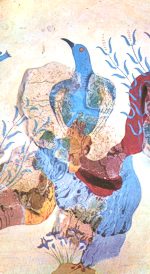Beyond the mists of legend there lies the remote civilization of Crete.
The Greeks always referred to Crete in connection with mythology; it was the cradle and refuge of Dias (Zeus) and the mother of gods, with the godlike Kings Minos and Radamanthys, judges of the underworld.

There are a multitude of other references to Crete in Greek mythology. Can it be that they were ignorant of the exact historical facts or was it that the Greeks with their wonderful artistic sense of harmony and moderation found the legends ideally suited to that superlative civilization? In any event, the written evidence is scanty and inaccurate; all that we have is what the archaeologist's spade has brought to light. One of the finds, the Phaestos Disc, has not yet been deciphered adequately, but it seems that the Minoans left no literature. On the other hand, in the rich selection of finds of every kind: vases, ceramics, stone images and figures, small ornaments and jewellery, sealstones and frescoes, we have wonderful examples of this unique civilization. Áll the finds have such grace and freedom and such variety in the choice of subject and execution, such reality and authority that the modern viewer is lost in admiration and lives for a while in another age.
No matter how often Crete came under foreign influence or how much the Cretans learnt from the art of other civilizations, it remains an indisputable fact that
Crete set its own inimitable stamp on everything it touched.
The architecture of the palaces was magnificent and had no connection, of course, with that of classical Greece with its insistence on symmetry. At first glance, it seems that improvisation was the order of the day and that one area joins another, seemingly haphazardly, that everything is arranged simply around a central court and that all the structures rise from different levels. This is what the casual observer sees, but a closer look is enough to reveal the existence of a coherent plan. The ingenious design and the perfect organization of space enabled the builders to find a wonderful solution to the problems of light, air and drainage in the great palaces -problems which still present difficulties today. Inside the palaces we admire the luxury as well as the practical benefits, which have only just become familiar in Greek villages (at least as far as sanitation is concerned) in this age of technological civilization.
Cretan literature was
remarkable during the Venetian period. There was a particularly
Cretan “Renaissance” which resulted from the combination of Cretan tradition, western influence (via Venice) and the influence of the Byzantine civilization and intellectual life.
It is in the field of
painting, both frescoes and icons, that Crete reached the peak of artistic creativity at its best. The famous
«Cretan School» produced leading craftsmen and attracted the attention of the world.
It would be a sad omission not to record, finally, the treasure- house of Cretan folk tradition:
songs, poetry, music, dances, folk art and architecture, all of which played a vital role in keeping the Cretan spirit alive during all the periods of foreign occupation.
After the union with Greece, Crete became part of the wider Greek world artistically and intellectually as well, and the significant contribution of the island is obvious in all aspects of cultural Life.